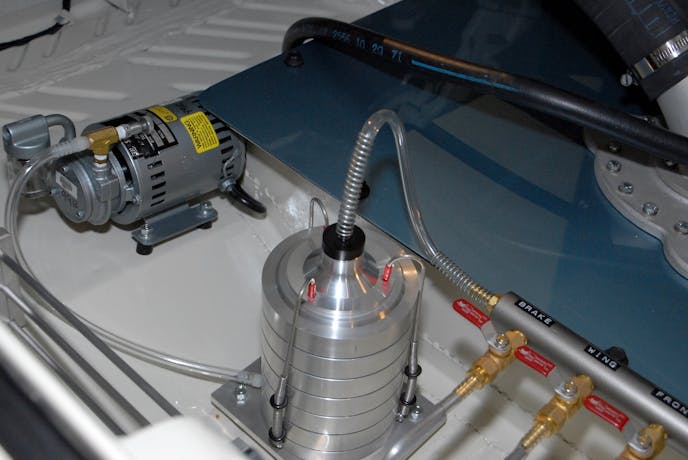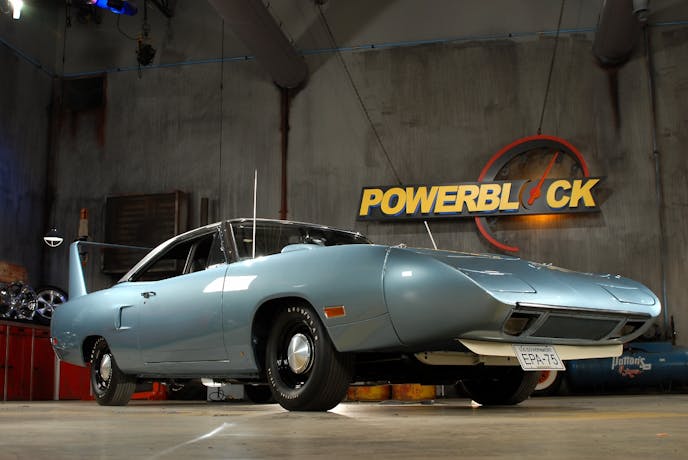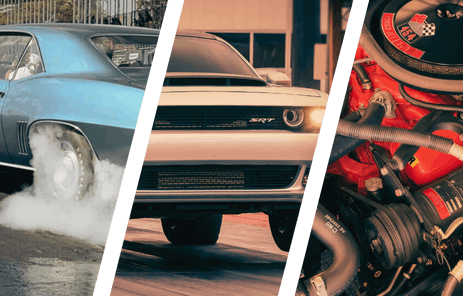A Rolling SuperBird Test Lab
Words and Photos By Cam Benty
When most muscle car fans think about 1970 Superbirds, they envision a wild, winged machine taking on the high banks at Talladega or Daytona. These cool cars were the pinnacle of the muscle car era with high compression engines and outrageous aerodynamics. Powered by at the very least a 440c.i. four-barrel Commando Mopar engine, Superbirds were as close to a NASCAR high bank-ready machine as you could purchase from the showroom.
But, the story behind this classic Superbird is quite the opposite of that mindset — a car built to not only test the “carbon footprint” of these massive machines back in 1972, but to provide data on other sources of emissions, including jet aircraft. This mobile collection lab was to help kill off not only leaded fuel, but point the finger at other common pollutants as subtle as brake dust and tire rubber. Come to the Barrett-Jackson auction April 6-8 in Palm Beach, Florida; it looks to change hands once again.
Legendary NASCAR builder Ray Nichols’ involvement
This 1970 Superbird started life simply, purchased new by Richard Kaminsky, who owned and enjoyed the Alpine White Bird for a few years before selling it to legendary NASCAR race car builder Ray Nichols. Ray had moved out of the NASCAR fold and began building his own vehicles for special purposes. The Superbird purchase followed the EPA’s acceptance of his bid to create a rolling test unit to collect emissions data.
Nichols’ team was to outfit the car with a wide assortment of test equipment and painted the exterior of the car (not the under hood, trunk or door jambs) with an Ice Blue Poly color, a Mopar color offered at the time, but not on Superbird models. Key modifications to the car included the addition of a roll cage, bucket seats in place of the bench unit, a fuel cell, charger quick flip gas cap, extending the twin exhaust tips out the back, and an elaborate modification of the electrical system.
The modifications also included an on-board air suspension system you could control from inside of the vehicle for raising the rear end, thus dropping the nose cone and keeping the car from flipping over from Jet Aircraft turbulence. In the event a fire broke out from the extensive electronics, an on-board fire suppression system was installed on the rear equipment shelf. A two-way aircraft radio would keep John Moran (the EPA’s designated driver), in touch with the aircraft tower so he would know when to give chase for jet emissions sampling.
Get the Lead Out
Nichols’ internal changes to the car included the addition of three more batteries, which mounted where the rear seat originally resided, and powered up not only the standard car charging system, but a power inverter to run 110V A/C current for the Anderson air sampler pump. In total, the car featured four batteries, two alternators, and two complete separate charging systems — just for starters. An elaborate ducting system allowed for gathering exhaust, tire debris, and brake pad dust pollution from outside of the car and drafting them to a collection point inside the trunk, where the effects could be reviewed in the lab after testing was complete.
From March 1972 through October 1973, EPA used the car in South Carolina for testing. The findings? That cars, especially muscle cars, are horrific polluters, and leaded fuel is at the core of the offense. If there can be a finger pointed at one vehicular culprit in the pollution standards blame game, this Superbird proved to be Darth Vader in Ice Blue Poly.
Mothballs
Like most government projects, once their time has passed, they are stockpiled like cordwood and forgotten. So was the case with this Superbird, which sat in the back lot of the South Carolina facility until 1979, when it was finally auctioned off. Listed along with lots of other scientific “junk” as simply a “Chrysler car,” it was purchased for $500 by local North Carolina resident Wilbur Walker — the only bidder for the cool Plymouth.
Excited about the purchase, Walker got the muscle car running again and drove it for some time with limited knowledge he received from the EPA, basically that it was a test vehicle from earlier in the decade. In the glove box, he would find the original EPA gas receipts verifying the car’s history, along with a Nichols Engineering plaque mounted to the dash and EPA Inventory sticker. Over the next several years, Walker would put the car back to a stock bench seat Superbird and have it repainted back to original Alpine White.
At one point, Walker decided he would sell the car and proceeded to send out 35 letters to the muscle car community alerting them about the sale of the vehicle. After a brief bidding war, the car was purchased by the current owner, who researched and restored the car back to its original EPA test configuration.

This is a truly significant car in the history of the American automobile. It is well documented in plenty of original articles, including one that ran in Car & Driver Magazine back in 1972. While the long-term significance of the car is plenty interesting, today’s muscle cars are better and more powerful for lessons learned here.
You might also like
Hurricane-Powered Ram Pickup First In The 8s!
Evans' elapsed time was an insane 8.89.3 at 149.10 mph with a 1.602 60-ft. time. You can almost hear the HEMI guys crying



